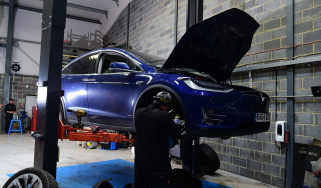Hyundai Veloster Turbo
The hot range-topping Veloster Turbo adds some spice to the quirky three-door package
In some ways, the Turbo isn’t much more than a stylised hatch. You get lots of equipment, respectable handling and decent straight-line pace, and if you need practicality as well as performance, it’s the better bet here. However, it lacks the X-factor that’d make you want to drive it just for the hell of it.
In recent years, Hyundai has earned a reputation for building sensible, great-value cars. Yet that all changed when the brand launched the quirky Veloster in 2011. With its bold lines, novel three-door layout and roomy cabin, it caused a real stir.
Even now, nearly two years after its launch, this model still attracts plenty of attention. You’d struggle to call it attractive, but the blend of straight lines, curves and fake body vents means it has no trouble standing out, even when parked alongside the high-riding Juke.
Interestingly, Hyundai’s designers have not been so bold with the interior, which looks and feels a little like that of the brand’s sensible i30 family hatch. This means a logical dashboard layout, solid finish and plenty of sombre black trim.
And unlike in the Juke’s racy cabin, there’s very little evidence of the Veloster’s performance potential – the only real clues are the slightly garish ‘Turbo’ logos embroidered on the front seats.
Used - available now

2020 Vauxhall
Corsa
13,870 milesManualPetrol1.2L
Cash £12,625
2019 Vauxhall
Mokka
41,000 milesManualDiesel1.6L
Cash £9,876
2019 Vauxhall
Mokka
39,016 milesAutomaticPetrol1.4L
Cash £10,483
2021 Land Rover
Discovery Sport
32,022 milesAutomaticPetrol2.0L
Cash £22,620Still, what the interior lacks in style, it makes up for with kit. You get an intuitive sat-nav set-up, climate control and leather trim – although the shiny hide looks a little fake. There’s a decent amount of space, too.
The large single rear door on the passenger side gives easy access to the back seats, and there’s more legroom than in the cramped Juke, but the tailgate comes perilously close to rear passengers’ heads. Yet while the 320-litre boot is nothing to write home about, it’s much more useful than the Nissan’s 251-litre load bay.
Buyers of this sort of car are more worried about pace than space, though, and in this respect the Hyundai is a mixed bag. A bland engine note and smooth power delivery mean it doesn’t feel as quick as the Nismo, and it needed an extra three-tenths to completeour 0-60mph sprint, taking 7.8 seconds.
But thanks to its more muscular 265Nm torque output, the Hyundai was quicker than its rival in our in-gear tests.
Away from the track, it also held a narrow advantage over the Juke. With its lower and wider stance, it suffers from less body roll when cornering hard, while its direct steering and strong grip inspire confidence. In fact, the only thing that spoils the fun is the vague shift action of the six-speed manual gearbox.
When you’re not blasting down back roads, the Hyundai is the more relaxing option. While there’s a similar amount of road noise as in the Juke, it has a more supple ride, and at 70mph its engine revs at a more relaxed 2,500rpm.
However, there is a catch. At £22,120, the Veloster is a hefty £1,725 more than the Nissan. The question is whether the slightly sharper driving dynamics and greater practicality are enough to justify this price premium.






